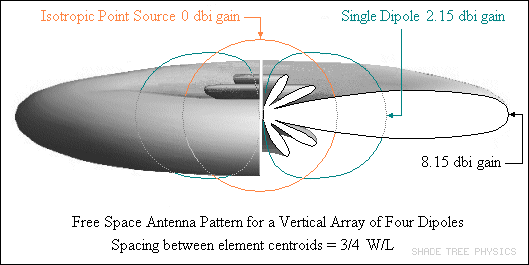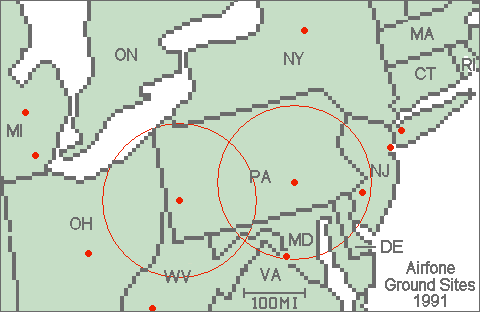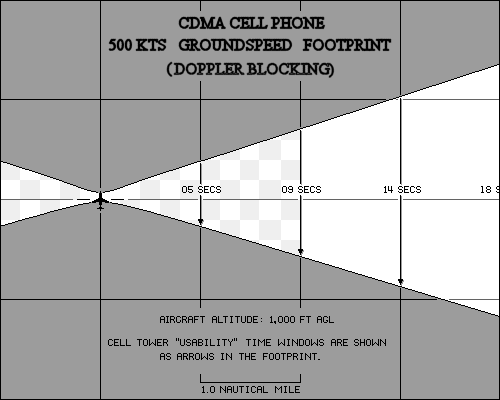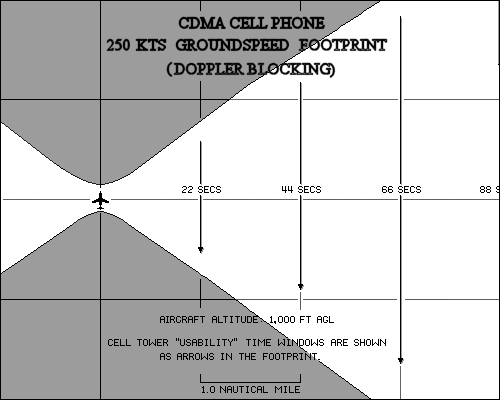Airborne Cell Phone Performance
Installed 01 Feb 2006. Latest update 28 Jul 2016.
New or revised text is in bold.
Canadian Airborne Cell Phone Tests
In 2003, Project Achilles researchers performed low altitude cell phone tests in private aircraft in the London, Ontario area of Canada. They found limited communications above 2,000 feet AGL (above ground level) and essentially no communications at 8000 feet AGL and above. The planes used in these tests had cruising speeds of 138 and 127 knots.
The following two diagrams are used to show (in part) why ordinary cell phones fail to work at altitudes at and above 8000 feet AGL above heavily populated urban areas.
The first diagram shows a "free-space" three dimensional equal-power surface for a four-element dipole vertical array, which is similar to many antennas used for cellular communications. The right hand side of the drawing is a cut-away version showing the pattern's internal lobe structure.
Antenna patterns for a point-source (orange circle) and a single dipole (green back-to-back ellipsoids) are also shown on the drawing. There aren't really any point source antennas but they serve as theoretical starting points for gain considerations. Antenna gains, with respect to the isotropic point-source, are given in dbi (decibels isotropic). For the single dipole and the four-dipole array the antennas are polarized vertically.

This antenna pattern, and the following drawing based on it, are based on a spacing of 3/4 wavelengths between centers of adjacent radiating elements.
This second diagram corresponds to the cut-away view above and shows where most of the transmit power and receive sensitivity are located for a typical, present day, cell phone tower.

Idealized 1900 MHz CDMA Coverage for an Urban Cellular Tower
The outer edge of the ground hugging lobe (shown in black) represents 5 bars of indicated received signal strength for a cell phone. Cell phones located on the ground or up to 2,000 feet or so should give good service. Above that altitude things can get shaky. (Caution! The "bars" information in this diagram may be too generous. If so, the usable "on station" time, discussed in the next paragraph, will be reduced.)
Consider a plane (red circle) flying at 120 knots at 8,000 feet above ground level (AGL), more or less toward the cell tower. A cell phone at the location shown should display no bars. At the plane's speed and altitude it would take about 26 seconds for it to transit the one-mile-thick radiation cone/lobe, as shown. That might allow enough time for the cell phone to be acquired by the cell tower, but then the usable signal disappears in the null between cones/lobes. Other flight paths can yield longer lobe transit times but for planes moving in straight lines, at similar altitudes, those times will be fleeting.
Many cellular tower antenna patterns can be tilted down by as much as 15 degrees to better serve selected ground users and in some cases to reduce background noise in adjacent cells. If that is done then signals at altitude are even weaker.
Rural area highway cellular towers are typically spaced from five to ten miles apart. To provide coverage at these longer ranges, cell towers may use, say, four times the transmit power as their urban counterparts and employ negligible down-tilts. With these factors in mind, there may be modest increases in workable altitudes for cell phones in rural areas, provided the airborne units are in the vicinity of these towers. (And outside United States air space!)
A Microsoft QuickBASIC program, which models antenna patterns similar to those
produced by 1900 MHz CDMA cell phone towers is available on this web-site at
ant-pat.bas.
U.S. Prohibition of Cell Phone calls While Airborne
''Cellular telephones installed in or carried aboard airplanes, balloons or any other type of aircraft must not be operated while such aircraft are airborne (not touching the ground). When any aircraft leaves the ground, all cellular telephones on board that aircraft must be turned off. The following notice must be posted on or near each cellular telephone installed in any aircraft: ''The use of cellular telephones while this aircaft is airborne is prohibited by FCC rules, and the violation of this rule could result in suspension of service and/or a fine. The use of cellular telephones while this aircraft is on the ground is subject to FAA regulations.''
Airfones
The following digram shows where Airfone ground radio sites were located in the northeastern USA in 1991. Two typical coverage areas, with estimated radii of 128 miles, are represented by the red circles.

Airfone ground Site locations in Northeast USA in 1991
Verizon acquired Airfone from GTE in 2000.
On June 23, 2006, Verizon Communications, Airfone's parent company, announced that they would be discontinuing their Airfone service on all commercial flights by the end of 2006. Verizon will continue to provide Airfone service on 3,400 private and government aircraft. Source: Wikipedia. (Use search term Airfone.)
Doppler Induced Cellular Service Blocking
Based on two take-off-roll tests (aircraft still on the ground) done by the author, it appears that for CDMA cell phones (1900 MHz), Doppler induced loss-of-service (no bars) occurs at relative speeds (aircraft to cell tower) of 150 kts (nautical miles per hour) and greater. At a speed of 150 kts, toward or away from a given cell tower, the Doppler shift for 1900 MHz signals is roughly 500 Hertz (cycles per second). The author notes that in cell phone system simulations, a Doppler offset of 480 Hertz is typically employed. Robust systems can apparently handle that amount of Doppler shift.
Since Airfone frequencies (849-851 MHz and 894-895 MHz) are about one half of that for 1900 MHz CDMA cell phones, the Airfone equipped aircraft speed, relative to a given Airfone ground station, could be on the order of 300 kts before Doppler blocking sets in.
The following diagram illustrates Doppler shift blockage of cellular signals for a mobile cell phone in an aircraft which is flying at a speed of 500 kts at an altitude of 1,000 feet. The grey area represents the region of no service (slant range speeds equal to or greater than 150 kts). Cell tower "usability" times are shown as arrows in the usable signal footprint. The shorter the times, the more problematic the chances are for actual communications to occur. [Added 12 Feb 2006. Modified 14 Feb 2006.]

Ground motion added 02 Aug 2007. (If the shaded squares
move in surges, then your internet pipe is probably clogged.)
The next diagram shows the cell phone footprint for an aircraft at 1000 feet AGL, as before, but traveling at a groundspeed of 250 kts. This situation is fairly representative of airliners making their final approaches for landings. It can be seen that there should be ample opportunity for cell phone communications using cellular towers located two to five miles to either side of the aircraft. [Added 13 Feb 2006.]

* * *
Related Links
[Added 22 Feb 2006.]
Top